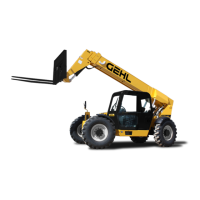PRINTED IN U.S.A. 53 913287/BP0808
fuel starts to
drain out.
c. When fuel
starts to drain
out, tighten
drain plugs
securely.
After draining water
from the fuel filters,
the filters must be
primed by bleeding all air from the fuel system. Refer
to the engine manual for proper fuel bleeding proce-
dures.
A drain plug is also provided in the bottom of the fuel
tank for removing condensation and other foreign
materials. Open the plug and allow water and fuel to
drain into a container until only clear fuel is flowing
from the tank.
CHECKING ENGINE OIL LEVEL
With the machine on level ground, and the engine
stopped for ten minutes or more, raise the engine hood
and remove the engine dipstick. Wipe it clean, re-insert
it and remove to obtain a reading. If the oil level is
below the crosshatch pattern on the dipstick, fill with
the required amount of oil to bring the level to within
the crosshatch pattern. Oil levels anywhere within the
crosshatch are considerred full. See the Lubrication
chapter for the type of oil to use.
CHECKING TRANSMISSION OIL LEVEL
The machine must be on level ground and the boom
lowered and completely retracted. With the engine and
transmission at operating temperature, parking brake
on, travel lever in Neutral and the engine at low idle,
raise the engine hood and remove the dipstick, located
by the front wall, and check the oil level. If the oil level
is below the ADD mark, fill into the tube with the
required amount of oil to bring the level to the FULL
mark. See the Lubrication chapter for the type of oil to
use.
CHECK RADIATOR COOLANT LEVEL
With the machine on level ground, remove the radiator
cap. If the coolant level is below the filler neck, add a
low-silicate ethylene glycol based coolant mixed with
quality water and supplemental coolant additives
(SCAs) suitable for heavy-duty diesel engines. See the
engine manual for additional information. Replace the
radiator cap securely.
NOTE: If the engine is operated with a loose radi-
ator cap, the pressure bypass will not work and
the engine will run hot.
CHECKING HYDRAULIC OIL LEVEL
The machine must be on level ground and the boom
lowered and completely retracted. With the engine
stopped for ten minutes or more, raise the engine hood.
Remove the dipstick located alongside the hydraulic
oil fill tube cap. If the oil level is below the ADD mark,
fill with the required amount of oil to bring the level to
the FULL mark. See the Lubrication chapter for the
type of oil to use.
IMPORTANT: Be careful when removing the
reservoir filler cap so that no dirt or other foreign
matter enters the hydraulic system. DO NOT
OVERFILL.
CHECKING TIRE PRESSURES
Proper and equal tire pressure should be maintained for
all four tires to enhance operating stability and extend
tire life.
When installing tires on the machine, be sure that all
tires are of the same size and type. ALWAYS replace
tires with the same size furnished as original equip-
ment. Replacement tires must be purchased locally.
Check the tire pressure “cold.” All 12-ply tires should
be inflated to 70 psi (480 kPa).
NOTE: If the tires have been filled with water or
calcium chloride for ballast, a calcium chloride tire
pressure gauge MUST be used to check the tire
pressure.
When removing tires, follow industry safety practices.
Deflate completely prior to removal. After assembly of
the tire on the rim, use a safety cage or restraining
device while inflating.
WARNING
DO NOT remove the radiator cap when the
engine is running hot or overheated. Coolant
is extremely hot and under pressure and it can
burn your skin. Allow sufficient time for the
radiator to cool BEFORE relieving the pres-
sure and removing the radiator cap.
Courtesy of Crane.Market

